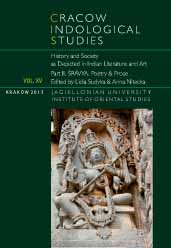Embracing Simultaneity: The Story of Śleṣa in South Asia
Embracing Simultaneity: The Story of Śleṣa in South Asia
Author(s): Yigal BronnerSubject(s): Cultural history
Published by: KSIĘGARNIA AKADEMICKA Sp. z o.o.
Keywords: śleṣa; polysemy; simultaneity; Kavirāja; Subandhu; Nītivarman; Daṇḍin; Jagaddhara Bhaṭṭa; Māgha; Śrīharṣa
Summary/Abstract: This essay deals with literary works that combine two or more topics, characters, or plotlines and convey them concurrently to their respective destinations. It is based on my monograph Extreme Poetry: The South Asian Movement of Simultaneous Narration (Bronner 2010), where I discuss this phenomenon at length. Here I will limit myself briefly to presenting three main points: that the dimensions of the śleṣa phenomenon in South Asia are enormous, that experiments with artistic simultaneity have a demonstrable and meaningful history, and that this is the history of a self-conscious literary movement. I conclude with three brief examples of śleṣa verses from three very different works that exemplify some of the poetic uses to which śleṣa was put and that demonstrate how the literary movement under discussion used śleṣa to advance the aesthetic projects of South Asian culture and push them to the extreme.
Journal: Cracow Indological Studies
- Issue Year: 2013
- Issue No: 15
- Page Range: 119-141
- Page Count: 23
- Language: English

